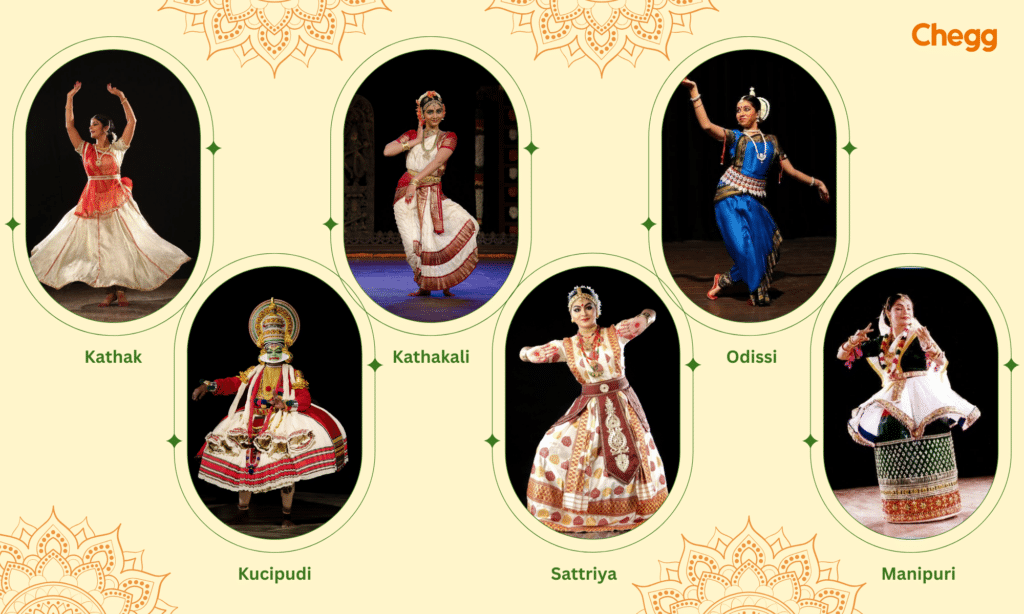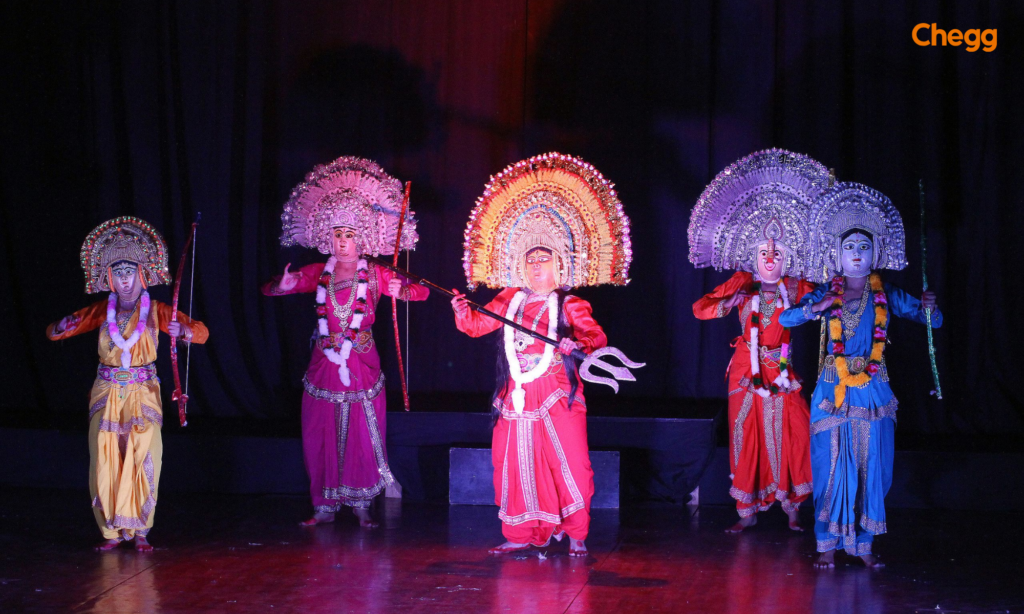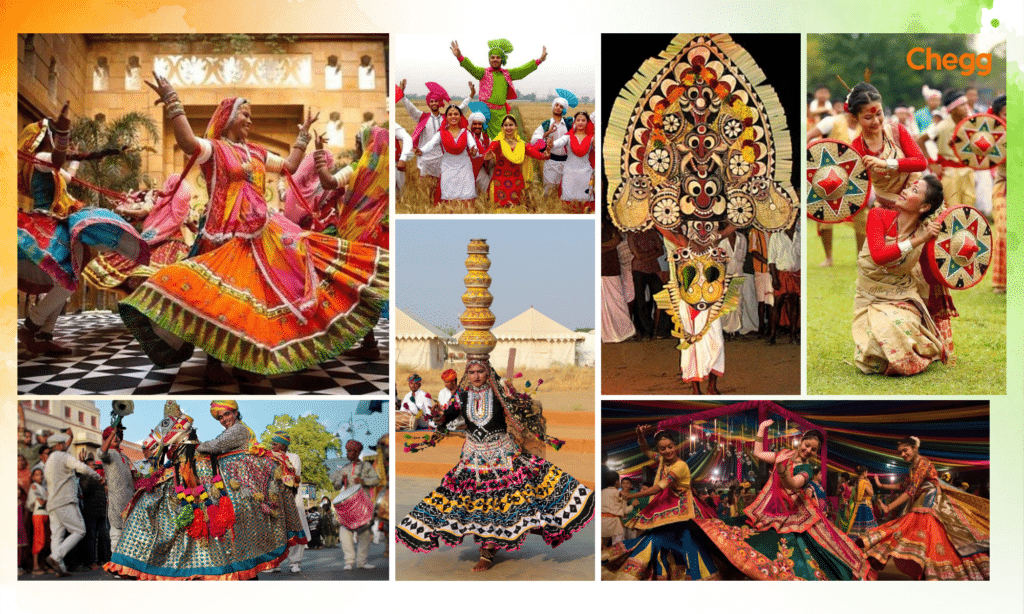Quick Summary
Table of Contents
Classical dance of India has an ancient tradition, rooted in temples where it was primarily used for worship. It traces its origins to the Natya Shastra, a Sanskrit text compiled between 200 BCE and 200 CE, which defines three key aspects of dance: Natya (dramatic), Nritya (expressional), and Nritta (pure dance). Over time, these dance forms evolved, leading to the development of distinct styles such as Bharatanatyam, Kathakali, Kathak, Manipuri, Odissi, Sattriya, Kuchipudi, and Mohiniyattam. Today, classical dance remains a vibrant expression of culture, blending storytelling with intricate movements and rhythms across India.
| Dance forms | States | Important Points |
| Bharatnatyam | Tamil Nadu | 1. Ekaharya dance style. 2. Emphasises expressive eye movements and hand gestures. 3. Accompanied by a traditional orchestra. 4. Comprises seven main parts in a typical performance. |
| Kathak | North India | 1. Derives from the word Katha, meaning story. 2. Historical temple and village origins. 3. Gained distinctive style in the 15th-16th centuries. 4. Notable for footwork and recitation of verses. 5. Associated with Hindustani music. |
| Manipuri | Manipur | 1. Rooted in Manipur’s rituals and traditional festivals. 2. Associated with gods, goddesses, and creation legends. 3. Lai Haraoba is the earliest dance form. 4. Ras, Sankirtana, and Thang-Ta are popular forms. 5. Kirtan accompanies Sankirtana. 6. Dancers use Pung and Kartal, no ankle bells. |
| Odissi | Odisha | 1. Features lore of Lord Vishnu and Jayadeva’s Gita Govinda. 2. Emphasises soft dance with graceful mudras. 3. Distinct postures like Tribhanga and Chowk. |
| Kathakali | Kerala | 1. Influenced by Kerala’s ritual performing arts. 2. Combines dance, music, and acting. 3. Elaborate costumes, masks, and makeup. 4. Depicts roles through makeup, narration, and music. 5. Uses facial colours to express the character. |
| Sattriya | Assam | 1. Introduced by Vaishnava saint Sankaradeva. 2. Governed by strict principles and religious character. 3. Two streams: Bhaona-related and independent dance numbers. 4. Chali is known for grace and Jhumura for vigour. 5. Traditional art linked to monasteries. |
| Kuchipudi | Andhra Pradesh | 1. Originated in Andhra Pradesh’s Kuchipudi village. 2. Developed as dance-drama. 3. Prominent use of costumes and jewellery. 4. Features both group and solo performances. 5. Notable solo items include Manduka Shabdam and Tala Chitra Nritya. |
| Mohiniyattam | Kerala | 1. Classical solo dance from Kerala. 2. Historical references in Vyavahar Amala and Ghoshayatra. 3. Structured by the Travancore Kings. 4. Combines elements of Bharatanatyam and Kathakali. 5. Performed by girls with delicate movements and subtle expressions. |
1. Ancient Roots:
2. Temple and Religious Origins:
3. Key Classical Dance Forms:
4. Decline During British Rule:
5. Revival in the 20th Century:
6. Modern Evolution:
7. Cultural Significance:
The 9 Rasas (emotions) in Natya Shastra, an ancient Indian text on performing arts by Bharata Muni, are the fundamental emotional experiences conveyed in classical dance, drama, and music. These Rasas form the core of Indian performance art and are essential in creating emotional engagement with the audience. Each Rasa is associated with specific moods, colors, and elements.
Here are the 9 Rasas:
1. Shanta (Peace or Tranquility)
2. Bhayana (Fear)
3. Raudra (Anger)
4. Vira (Heroism)
5. Karuna (Compassion)
6. Haasya (Laughter or Humor)
7. Adbhuta (Wonder or Amazement)
8. Shringara (Love or Romance)
9. Bhakti (Devotion)
Classical dance of India is a diverse and culturally rich art form, deeply rooted in the country’s ancient traditions and classical texts like Bharata’s Natyashastra. This art form encompasses various regional styles with unique characteristics and influences. There are various classical dance forms in India. The classical dance of India not only showcases the skill of the dancer but also communicates profound stories from mythology and ancient texts.
According to the Natya Shastra, Lord Brahma created a new art form called Natya Veda by taking elements from the four Vedas—speech from the Rig Veda, gestures from the Yajur Veda, music from the Sam Veda, and emotions from the Atharva Veda. This unique blend formed a rich performance tradition that combined dance, drama, and music. It was meant to entertain, educate, and uplift both gods and humans. Indian mythology reflects this through divine dances like Shiva’s powerful tandava and Parvati’s graceful lasya. The importance of dance is also seen in ancient art, such as the Bhimbetka cave paintings and the bronze dancing girl from the Harappan civilization. Bharata Muni described dance as the “complete art,” as it brings together movement, music, poetry, storytelling, and spiritual expression.
There are 8 classical dances of India. Go through the points given below to learn the description and origin of these classical dances:

It is one of the most renowned classical dance forms, deeply grounded in the principles outlined in Bharata’s Natyashastra. It features an extensive collection of songs in languages like Telugu, Tamil, and Sanskrit. The themes explored in Bharatanatyam range from human emotions to divine love, classified as shringara (romantic love) and Bhakti (devotion).
It is the prominent classical dance of northern India, still widely practised in regions like Uttar Pradesh, Rajasthan, Delhi, and more. This dance form is closely associated with the tradition of Kathakaras, or storytellers, who have transmitted scriptures, epics like the Ramayana and Mahabharata, and Puranic literature through storytelling for centuries.
It is a traditional dance style from Andhra Pradesh. It was strongly influenced by the Bhakti movement, a religious and cultural revival that began around the 7th century AD. Kuchipudi is a unique form of dance that blends different elements. Dancers use intricate footwork, hand movements, and facial expressions to convey emotions and stories through the songs.
This dance originated in Orissa, the easternmost state of India, where it was originally performed by female temple employees known as maharis. In the mid-20th century, Odissi was redefined as theatre art, drawing inspiration from existing dance traditions, sculptures, paintings, and medieval Orissa literature.
It is often referred to as a story play, which emerged in the 17th century in Kerala under the patronage of the prince of Karnataka. It is renowned for its performances based on the epic Ramayana in Malayalam, the local language. Elaborate costumes, intricate facial makeup, and stylized movements characterize the plays, making them a visual spectacle.
This dance form originated in the monasteries of Assam during the 16th century. It is closely associated with the Vaishnava faith, spread by the saint and reformer Shankaradeva. Sattriya is a distinct classical dance form with a vocabulary of hand gestures, footwork, and a repertoire rooted in Krishna devotion.
This dance hails from Manipur in northeastern India and is deeply connected to the Vaishnava beliefs of the Meiteis. It is divided into two sections, jagoi, and cholom, corresponding to the lasya and tandava elements in Sanskrit literature. These are distinct styles dancers specialize in one form within this spectrum.
Originating in Kerala, it is named after the mythical enchantress Mohini. It is characterized by feminine grace and is closely associated with temple performances. The dance employs rhythms unique to Kerala and features instruments like the Maddalam and Edakka.
India has a rich heritage of classical dances, and among them, the Ministry of Culture, Government of India recognized Chhau as the 9th classical dance of India. Chhau is a unique blend of folk, tribal, and martial arts, making it distinct and fascinating. The name Chhau is derived from the Sanskrit word Chaaya, meaning shadow, image, or mask. It is also linked to the Odia word ‘Chhauni,’ which means military camp. Traditionally, it is a dance performed by male troupes. Chhau dance has three main types, each originating from a different region. The classical dance of India not only showcases the skill of the dancer but also communicates profound stories from mythology and ancient texts.

It comes from the Seraikela Kharsawan District of Jharkhand. It was patronized by local administrators who were dance instructors and skilled mask makers. It’s a martial dance performed by men, and symbolic masks are integral to this type. These masks represent various characters, animals, birds, and ideas, adding depth and symbolism to the performance.
It hails from the Mayurbhanj District of Odisha. It includes tribal, folk art, martial, local art forms, and classical and traditional art forms. Unlike Seraikella Chhau, Mayurbhanj Chhau does not involve the use of masks.
It is from the Purulia District of West Bengal. This form stylizes and incorporates incredible spins, focusing on the triumph of good over evil. Purulia Chhau employs masks from Hindu mythology that represent its character, often accompanied by elaborate headgear.
These various classical dance forms reflect the diversity of India’s cultural heritage and the enduring influence of ancient texts and traditions in shaping its rich artistic legacy.
The Classical and folk dances of India have striking differences. Classical dances, rooted in ancient texts like Natya Shastra, encompass Lasya and Tandava, emphasizing spirituality and demanding technical precision. Trained professionals perform them, radiating grace and composure. In contrast, folk dances evolve from people’s lives, set to local music, celebrating harvests, weddings, and social gatherings. The graceful movements and expressive gestures of the classical dance of India require years of rigorous training and dedication.

Northern India boasts a rich tapestry of classical dance styles. The classical dance of North India is Kathak. This dance form traces its origins to storytellers in the northern plains of Uttar Pradesh. Each classical dance of India has its own distinct vocabulary, with gestures (mudras) and facial expressions (abhinaya) playing a key role in performance. Originally, Kathak was a hereditary tradition, with dance routines passed down through generations.
Also Read:-
Ganesh Chaturthi | Why we celebrate
The Nightingale of India: Sarojini Naidu and Lata Mangeshkar
Holi Festival: A Fun Guide to What it is and Why We Celebrate
Coldest Planet in the Solar System: Discover the Chilly Realm
Cyclone in India: Types, Names and How Are Cyclones Named.
List of famous personalities of India
Leila Seth: The First Woman Chief Justice of India

Classical dance of India is a diversified and multicultural art form that has its roots in the country’s ancient customs and literary classics like Bharata’s Natyashastra. Bharatnatyam, Kathakali, Kathak, Manipuri, Odissi, Sattriya, Kuchipudi, and Mohiniyattam are some classical dance styles that have developed over time. The classical dance of India is not just an art form; it is also a means of preserving history, culture, and storytelling through generations. Classical dances of North India, particularly Kathak, have a rich history of evolution, influenced by Mughal patronage, regional diversity, and cultural shifts, making them a vital part of India’s cultural heritage. These dances have survived the test of time and continue to enchant audiences worldwide.
Classical dance forms of India are a living testament to the country’s rich cultural heritage, blending intricate techniques, deep spiritual roots, and storytelling traditions. From the devotional rituals of ancient temples to modern global stages, these dance forms have evolved while maintaining their core values of grace, discipline, and expression. They reflect the diversity of India’s regions, languages, and philosophies, and continue to be a powerful medium for cultural preservation and innovation. Classical dance of India not only connects the past with the present but also plays a vital role in the global appreciation of India’s artistic legacy. As these forms evolve, they remain integral to India’s cultural identity, offering a window into its history, values, and artistic excellence.
The classical dance forms of India are Bharatnatyam, Kathak, Kathakali, Manipuri, Odissi, Mohinioyattam, Sattriya, and Kuchipudi.
The 9 rasas are; Shringara, Roudra, Bibhatsa, Veera, Shaant, Haasya, Karuna, Bhayanak, and Adbhuta.
The oldest classical dance of India is Bharatanatyam, originating from Tamil Nadu. It has a history of over 2,000 years and is deeply rooted in religious and cultural traditions.
Kathak is a classical dance form of India that is famous in the regions of Uttar Pradesh, Rajasthan, and Delhi.
Uday Shankar is widely regarded as the “Father of Modern Dance in India.” He was instrumental in blending Indian classical dance with contemporary elements, helping to bring Indian dance to international recognition.
There are 8 officially recognized classical dance forms in India. These include Bharatanatyam, Kathak, Kathakali, Kuchipudi, Odissi, Manipuri, Mohiniyattam, and Sattriya.

Authored by, Amay Mathur | Senior Editor




Amay Mathur is a business news reporter at Chegg.com. He previously worked for PCMag, Business Insider, The Messenger, and ZDNET as a reporter and copyeditor. His areas of coverage encompass tech, business, strategy, finance, and even space. He is a Columbia University graduate.
Editor's Recommendations
Chegg India does not ask for money to offer any opportunity with the company. We request you to be vigilant before sharing your personal and financial information with any third party. Beware of fraudulent activities claiming affiliation with our company and promising monetary rewards or benefits. Chegg India shall not be responsible for any losses resulting from such activities.
Chegg India does not ask for money to offer any opportunity with the company. We request you to be vigilant before sharing your personal and financial information with any third party. Beware of fraudulent activities claiming affiliation with our company and promising monetary rewards or benefits. Chegg India shall not be responsible for any losses resulting from such activities.